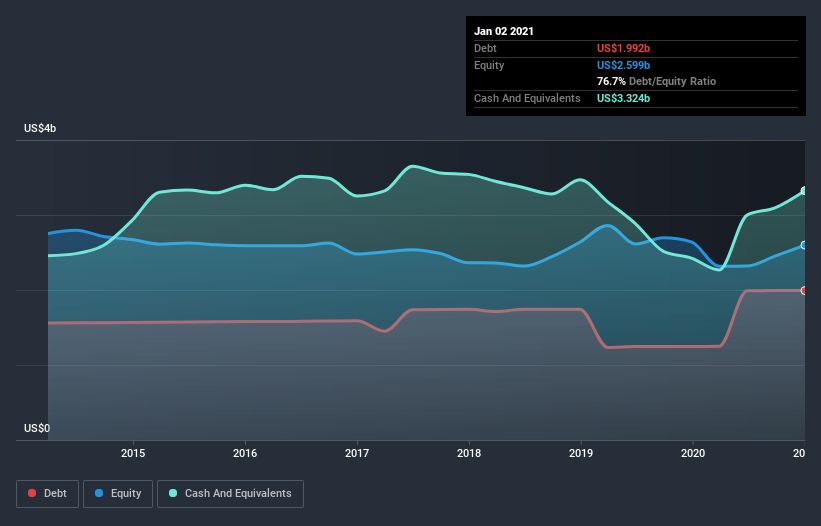Does Xilinx (NASDAQ:XLNX) Have A Healthy Balance Sheet?
David Iben put it well when he said, 'Volatility is not a risk we care about. What we care about is avoiding the permanent loss of capital.' It's only natural to consider a company's balance sheet when you examine how risky it is, since debt is often involved when a business collapses. We can see that Xilinx, Inc. (NASDAQ:XLNX) does use debt in its business. But should shareholders be worried about its use of debt?
When Is Debt A Problem?
Debt is a tool to help businesses grow, but if a business is incapable of paying off its lenders, then it exists at their mercy. Ultimately, if the company can't fulfill its legal obligations to repay debt, shareholders could walk away with nothing. While that is not too common, we often do see indebted companies permanently diluting shareholders because lenders force them to raise capital at a distressed price. Of course, debt can be an important tool in businesses, particularly capital heavy businesses. When we examine debt levels, we first consider both cash and debt levels, together.
Check out our latest analysis for Xilinx
How Much Debt Does Xilinx Carry?
The image below, which you can click on for greater detail, shows that at January 2021 Xilinx had debt of US$1.99b, up from US$1.25b in one year. But it also has US$3.32b in cash to offset that, meaning it has US$1.33b net cash.
How Strong Is Xilinx's Balance Sheet?
Zooming in on the latest balance sheet data, we can see that Xilinx had liabilities of US$1.11b due within 12 months and liabilities of US$2.04b due beyond that. Offsetting this, it had US$3.32b in cash and US$269.6m in receivables that were due within 12 months. So it actually has US$444.0m more liquid assets than total liabilities.
Having regard to Xilinx's size, it seems that its liquid assets are well balanced with its total liabilities. So while it's hard to imagine that the US$32.8b company is struggling for cash, we still think it's worth monitoring its balance sheet. Simply put, the fact that Xilinx has more cash than debt is arguably a good indication that it can manage its debt safely.
But the bad news is that Xilinx has seen its EBIT plunge 11% in the last twelve months. We think hat kind of performance, if repeated frequently, could well lead to difficulties for the stock. The balance sheet is clearly the area to focus on when you are analysing debt. But ultimately the future profitability of the business will decide if Xilinx can strengthen its balance sheet over time. So if you want to see what the professionals think, you might find this free report on analyst profit forecasts to be interesting.
Finally, while the tax-man may adore accounting profits, lenders only accept cold hard cash. While Xilinx has net cash on its balance sheet, it's still worth taking a look at its ability to convert earnings before interest and tax (EBIT) to free cash flow, to help us understand how quickly it is building (or eroding) that cash balance. Over the last three years, Xilinx actually produced more free cash flow than EBIT. There's nothing better than incoming cash when it comes to staying in your lenders' good graces.
Summing up
While it is always sensible to investigate a company's debt, in this case Xilinx has US$1.33b in net cash and a decent-looking balance sheet. And it impressed us with free cash flow of US$1.1b, being 123% of its EBIT. So we don't think Xilinx's use of debt is risky. The balance sheet is clearly the area to focus on when you are analysing debt. But ultimately, every company can contain risks that exist outside of the balance sheet. For example, we've discovered 2 warning signs for Xilinx that you should be aware of before investing here.
At the end of the day, it's often better to focus on companies that are free from net debt. You can access our special list of such companies (all with a track record of profit growth). It's free.
This article by Simply Wall St is general in nature. It does not constitute a recommendation to buy or sell any stock, and does not take account of your objectives, or your financial situation. We aim to bring you long-term focused analysis driven by fundamental data. Note that our analysis may not factor in the latest price-sensitive company announcements or qualitative material. Simply Wall St has no position in any stocks mentioned.
Have feedback on this article? Concerned about the content? Get in touch with us directly. Alternatively, email editorial-team (at) simplywallst.com.


